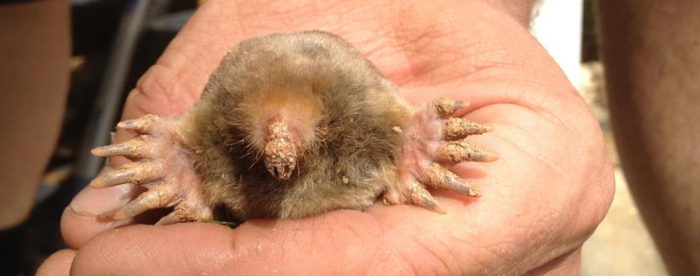MOLE OVERVIEW
Moles can destroy a lawn and drive you mad! If you’re like most homeowners, you’re probably confused by all the conflicting “advice” on mole control. In fact, chemicals and home remedies (including castor oil derivatives like Mole Med and grub controls) are not only ineffective when dealing with moles, but they allow the animals time to establish and multiply. Moles can quickly colonize and spread through adjacent residential properties if not handled properly. Since they need a well-established tunnel network to survive, the longer they’re allowed to tunnel, the more habituated they become and difficult to control. Mole Trapping is the only effective method of control.

TRAPPING & BAITING COMBO –
Our approach to controlling a mole situation usually involves Two (2) standard measures: Trapping & Baiting. If you want to be proactive and increase the chances of the trapping being effective, you could go walk in your yard and press down on the tunnels. Therefore, when the tech arrives all tunnels that are present are active tunnels. This allows us to have laser focus and make the most out of your trapping.
MOLE TRAPPING: The first step is setting traps in the active tunnels. These traps are designed to kill them quickly underground & humanely.
MOLE BAITING: When appropriate we can strategically place mole bait underground to attract the moles and once they eat the bait they die. We flag where there is bait and have a method to retrieve bait before we leave if they have not taken the bait away. Either way, the problem is resolved.
We charge a flat-rate fee for our mole control services and we have found this to be the most we can do as humans to have the upper hand in controlling the mole population in our yard.
MOLE BEHAVIOR & CONTROL
Since few homeowners want to bother with it or are lacking experience (know-how) to effectively trap moles, there is a population explosion. Despite all knowledgeable sources advocating trapping as the only reliable approach to a mole problem, it is more common to see homeowners still pouring chemicals, pumping the soil full of gases, buying up sonic devices and trying age old home remedies that never have worked.
The common mole is an insectivore, not a rodent. Its diet is restricted to grubs, millipedes, ants and the like. However, the mole’s primary food source is earthworm, so trying to control grubs and lawn insects is no protection from mole activity. The activity in certain lawns can simply come and go throughout the season.
On larger properties the activity may move from one part of the lawn to another. This movement or migration is controlled by climate and ground moisture.
Moles may leave an area if disturbed but will usually return when you least expect it. Even without disturbance mole activity may last only a week or two in a specific area. This here-now gone-tomorrow behavior is probably the root of most of the subjective misconceptions that make some home remedies including mole poisons appear credible.
Subjective misconceptions are also the root of such remedies as lye, human hair, pickle juice, broken glass, red pepper, razor blades, bleach, moth balls, rose branches, ultrasonic devices, castor bean products, gasoline and explosives. Although this approach may relieve frustrations, these and other home remedies have little if any value in controlling moles.
